💖 HEART to Heart
Helping Everyone Align, Reinforce, and Thrive
Walk beside, not ahead. Support with compassion. Thrive together.


🌿 Why HEART?
FLOURISH is a values-guided coaching journey for adults with ADHD — a path from chaos to clarity, from reaction to intention. It teaches skills like attention control, emotional regulation, values alignment, and routine-building in ways that honour how ADHD brains actually work: dynamically, sensitively, and creatively.
But no journey is walked alone.
The HEART companion was created for family members — partners, parents, siblings, friends — who want to support their loved one without disempowering them. It recognises that ADHD isn’t just an individual experience — it’s a shared ecosystem. When one person struggles with executive functioning, the ripple effects touch everyone. But so too can the growth.
HEART gives families insight into the ADHD experience and the FLOURISH framework, so they can reinforce progress, co-regulate during hard moments, and co-create a home environment that promotes stability, safety, and shared success.
🫶 The HEART Framework
Each section of HEART corresponds to a key family-based support skill, backed by science, and mapped to the FLOURISH journey your loved one is taking.
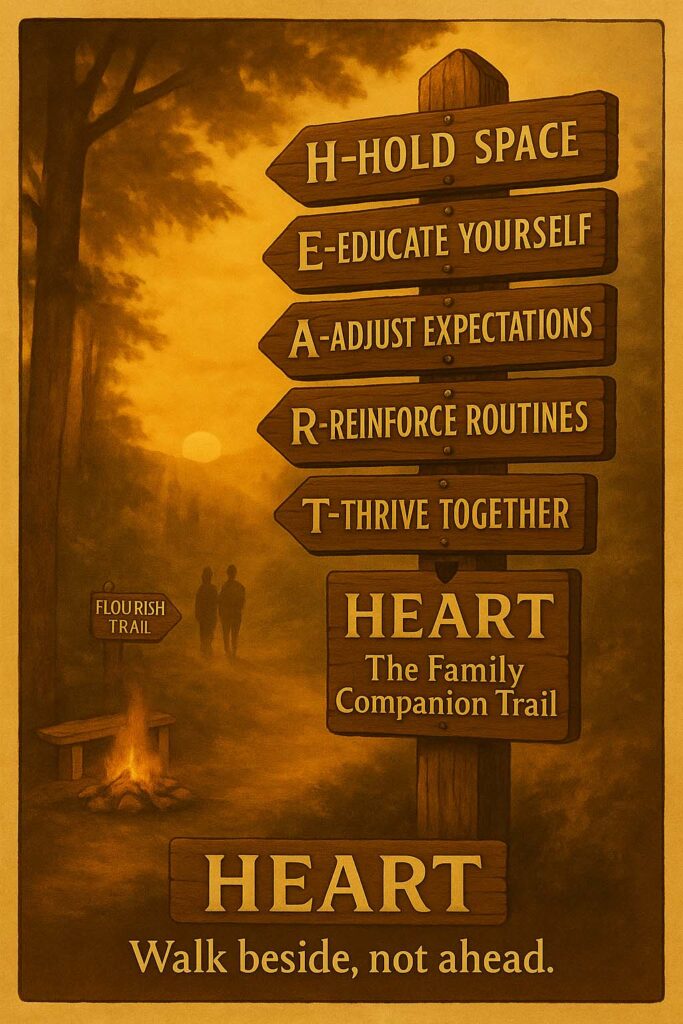

❤️ H – Hold Space
Be the calm in their storm.
When someone with ADHD is overwhelmed, their brain often floods with emotion, narrowing their capacity for reasoning and regulation. In these moments, what they need most is not a solution — but a steady, non-judgemental presence. “Holding space” means staying connected and compassionate without rescuing or correcting.
This mirrors co-regulation — a process where a calmer nervous system helps soothe a dysregulated one. By practising calm tone, open body language, and attuned listening, you become a safe harbour when internal storms surge. In FLOURISH, this supports phases like Instil, Reflect, and Safe — where emotional resilience is built.

🧠 E – Educate Yourself
Learn the terrain to walk it wisely.
ADHD isn’t a character flaw — it’s a difference in brain development, especially in the prefrontal cortex and dopamine pathways. These differences affect attention, time perception, motivation, and emotional control. Understanding this transforms frustration into empathy.
This section distils the neuroscience into practical insight. You’ll explore why task-switching is so hard, how rejection sensitivity shows up, and why “just try harder” often backfires. As you grow your understanding, you reduce shame — for you and your loved one — and open the door to true collaboration. In FLOURISH, this mirrors the Focus and Learn phases.

🪶 A – Adjust Expectations
Redefine success. Honour effort.
People with ADHD often live with internalised failure due to missed deadlines, forgotten tasks, and emotional blowups — many of which are tied to executive function lag, not laziness. When families cling to neurotypical timelines or definitions of “productivity,” it can erode connection and fuel burnout.
Here, you’ll learn to shift your lens: to celebrate progress over perfection, to honour recovery after a meltdown, and to value emotional safety as much as achievement. This approach aligns with the Optimise and Unite phases of FLOURISH — where new habits begin to take shape in realistic, compassionate ways.

🔗 R – Reinforce Routines
Be a rhythm-builder, not a rule-enforcer.
Habits don't stick through willpower — especially for ADHD brains. Instead, they form best through gentle repetition, environmental design, and emotional relevance. You can play a powerful role by helping your loved one identify their anchors, troubleshoot setbacks, and celebrate even the tiniest wins.
This section introduces concepts like habit stacking, cue-based routines, and "body doubling" — strategies grounded in behavioural psychology and supported by the Unite and Optimise phases of FLOURISH. Your goal isn’t to supervise — it’s to support rhythm without pressure.

🌱 T – Thrive Together
Support isn’t sacrifice — it’s connection.
ADHD affects relationships — often increasing conflict, miscommunication, and emotional whiplash. But it also presents a unique opportunity for radical honesty, emotional depth, and shared resilience. The path to thriving together includes rituals of repair, strength-spotting, and shared growth.
Here, you'll explore ways to co-create meaningful moments and repair ruptures when they arise. We’ll guide you through strengths-based connection rituals, reflection prompts, and collaborative value-setting — so your relationship doesn't just survive ADHD, it grows stronger because of it. This ties deeply to the Hope and Reflect phases of FLOURISH.
💬 A Final Word
Together, Not Perfect.
Supporting someone with ADHD isn’t about getting it all right. It’s about showing up, learning together, and realising that growth happens in connection. The HEART hub will walk beside you as you walk beside them — not to take over their journey, but to steady the terrain so both of you can keep moving forward.
FLOURISH with HEART — and let your family grow in clarity, calm, and connection. 🌿

📝 Walk-Beside Pledge
A Values-Based Family Agreement for Compassionate Support
This printable pledge is more than just a statement — it's a shared commitment to support with empathy, set healthy boundaries, and grow together. Designed to be read aloud, signed, or even framed as a visible reminder, the Walk-Beside Pledge helps families reorient from frustration to intention, from over-helping to aligned support.
🌿 The Walk-Beside Pledge
I promise to walk beside you — not ahead of you, not behind you — but with you.
- I will seek to understand before I assume.
- I will honour your efforts, even when outcomes fall short.
- I will set boundaries with love, not resentment.
- I will celebrate your strengths, not just monitor your struggles.
- I will not expect perfection — from you or from myself.
- I will return to compassion when things fall apart.
Together, we will grow — with clarity, with care, and with HEART.
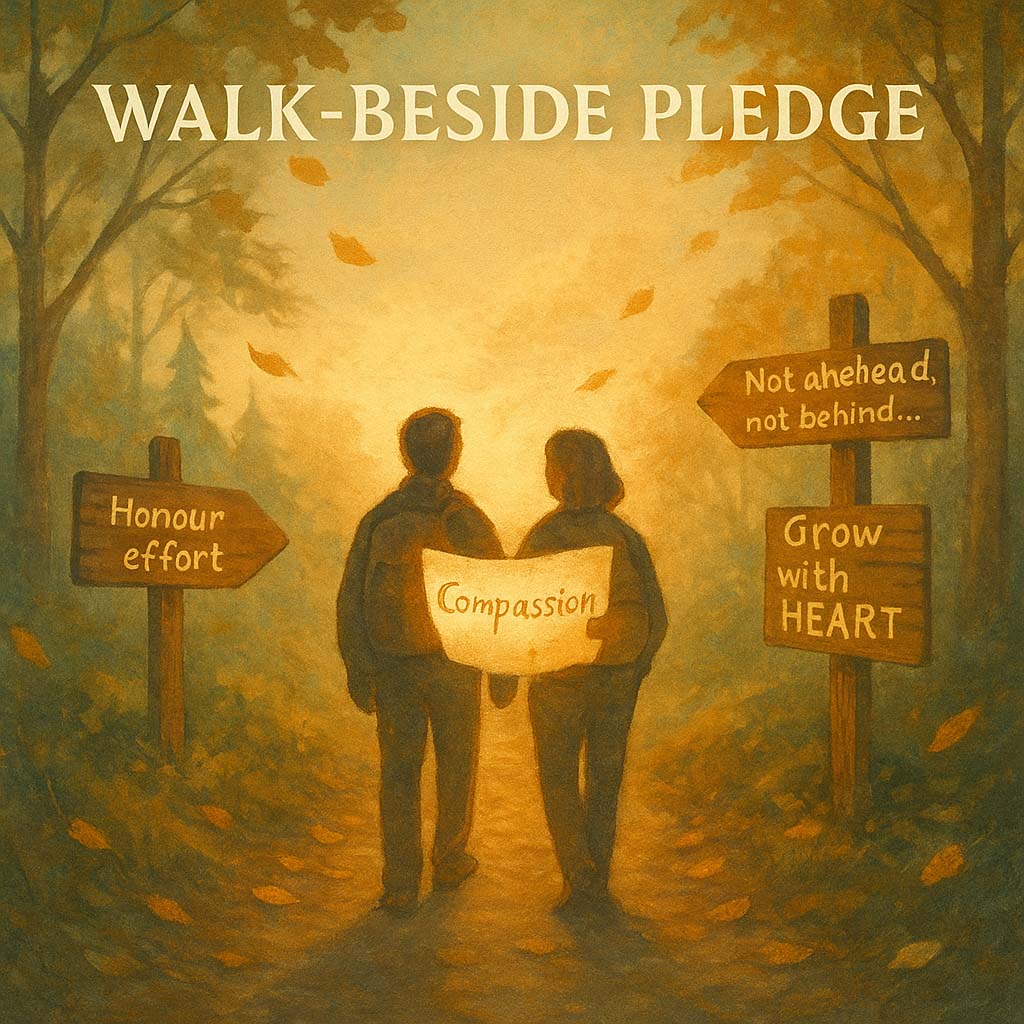

✅ Quick Tips Sheet
"10 Ways to Support Your Loved One with ADHD Today"
A beautifully designed one-pager you can stick on the fridge, pin to your corkboard, or share with other family members. These are bite-sized, evidence-informed strategies that make a big difference in daily life — especially when stress is high or communication gets tricky. Consider the following:
- Pause before you problem-solve.
- Validate their experience — even if you don’t fully understand it.
- Use gentle prompts, not harsh reminders.
- Celebrate progress, not just outcomes.
- Say “with” more than “for” — invite collaboration.
- Recognise overstimulation before it erupts.
- Body double instead of micro-manage.
- Create a safe “reset” space, not a punishment zone.
- Encourage recovery after hard moments.
- Keep it short, clear, and kind.
This tip sheet aligns with the HEART values and reinforces skills from the FLOURISH coaching journey. It’s ideal for busy households who want just-in-time support without needing to read a full manual.
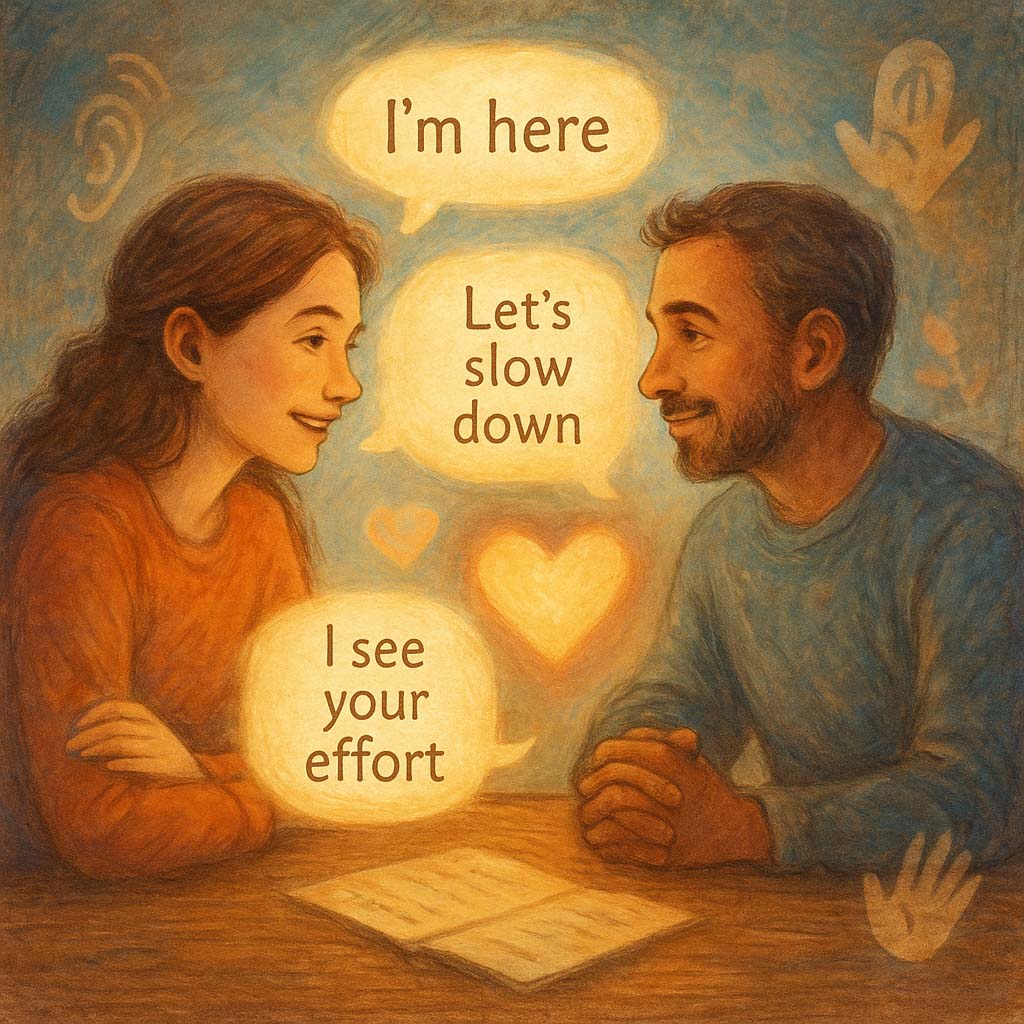
🗣️ Scripts & Sayings
“Words That Soothe, Not Shame”
ADHD brains are often sensitive to tone, timing, and perceived judgment. The wrong words — even when well-intentioned — can trigger shutdown, shame, or emotional escalation. This downloadable toolkit offers simple, values-based scripts for common family situations, helping you respond with compassion and clarity. Consider the following:
🌪️ When emotions are high: Instead of: “Calm down!” ~ Say: “I can see this is a lot right now — I’m here and we can slow down together.”
🔁 When something is forgotten (again): Instead of: “You never remember anything!” ~ Say: “Want me to help you build a reminder system that works better for you?”
⏱️ When they’re running late: Instead of: “Why can’t you ever be on time?” ~ Say: “What’s the hardest part about getting out the door? Let’s problem-solve that piece.”
😔 When they feel like a failure: Instead of: “Just try harder next time.” ~ Say: “That didn’t go how you hoped — but I’m proud of how you’re showing up.”
🎉 When you want to encourage: Instead of: “Finally, you did it.” ~ Say: “I noticed you followed through — that takes effort. Well done.”
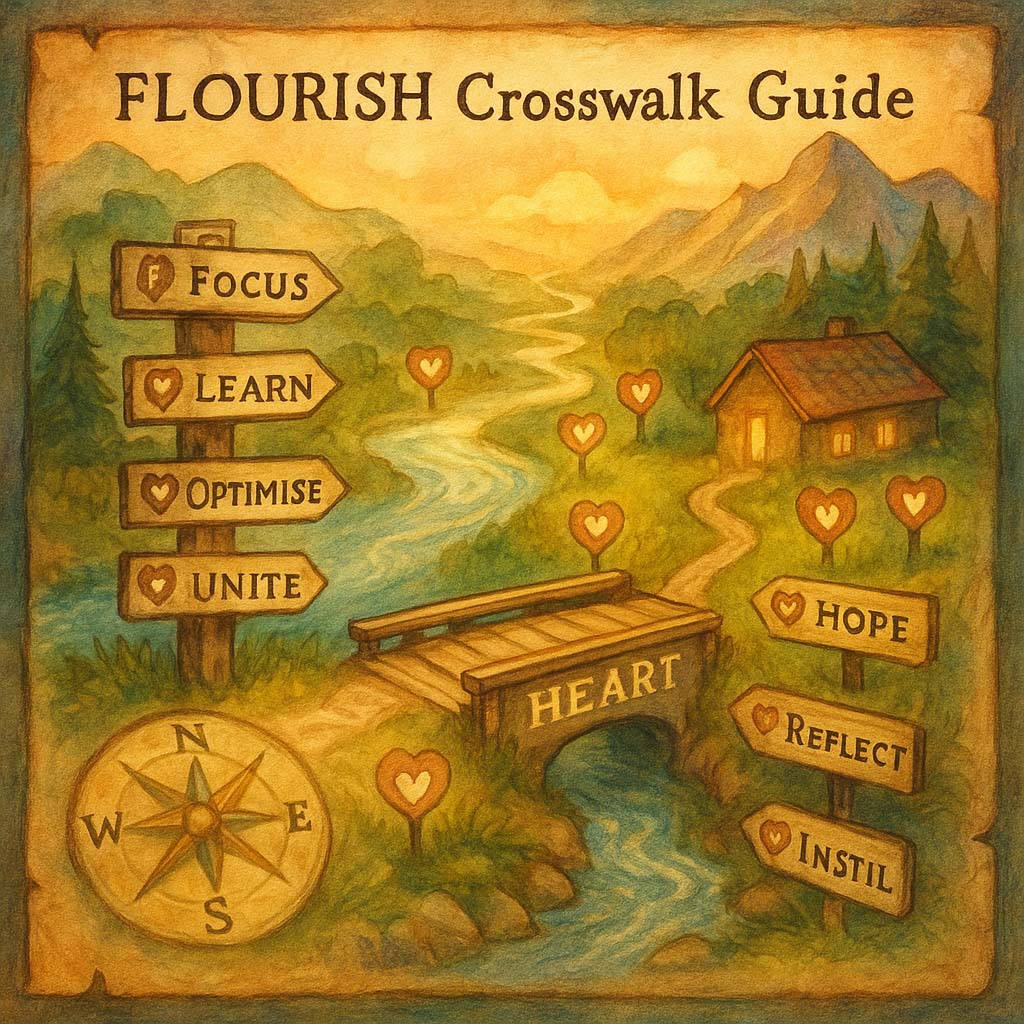
🧭 FLOURISH Crosswalk Guide
How HEART Helps You Support the FLOURISH Journey
The FLOURISH Crosswalk Guide shows how each stage of the FLOURISH coaching framework can be supported by a matching HEART strategy — helping families and loved ones know when to step in, how to step back, and how to offer meaningful, values-based support.
🔍 In the Focus phase, your loved one is working to gain clarity and strengthen attention. You can support this by educating yourself about ADHD — especially how attention challenges work — and by avoiding overwhelming them with too many demands.
📘 During the Learn phase, they begin to explore their ADHD symptoms with curiosity rather than shame. Your role is to stay open and informed — replacing blame with insight, and asking questions that deepen their self-understanding.
🛠️ As they move into Optimise, they begin building external systems to support internal functioning. Here, you can help by adjusting expectations — offering encouragement without pressure, and respecting the learning curve of trial and error.
🔗 In the Unite phase, they link habits into daily routines. You can help by reinforcing these routines — celebrating their consistency, offering gentle reminders, and normalising the ups and downs that come with building structure.
🌀 When your loved one enters the Reflect phase, they may be processing difficult emotions, identity shifts, or past experiences. The best support you can give is to hold space — listening without fixing, reflecting back their effort, and honouring their emotional process.
🧘♂️ The Instil phase focuses on regulation and return-to-calm strategies. Your continued steady presence is key here. Model emotional resilience, and be a grounding influence during emotional storms.
🛟 In the Safe phase, the goal is to create proactive plans for emotional risk. This is where you can hold space even more deeply — and make use of the Walk-Beside Pledge. Offer calm support when needed and collaborate on compassionate action plans in advance.
🧭 Finally, in the Hope phase, your loved one reconnects with their core values and direction. This is where you can thrive together — sharing your own values, celebrating their growth, and creating rituals of purpose and joy that support long-term resilience.
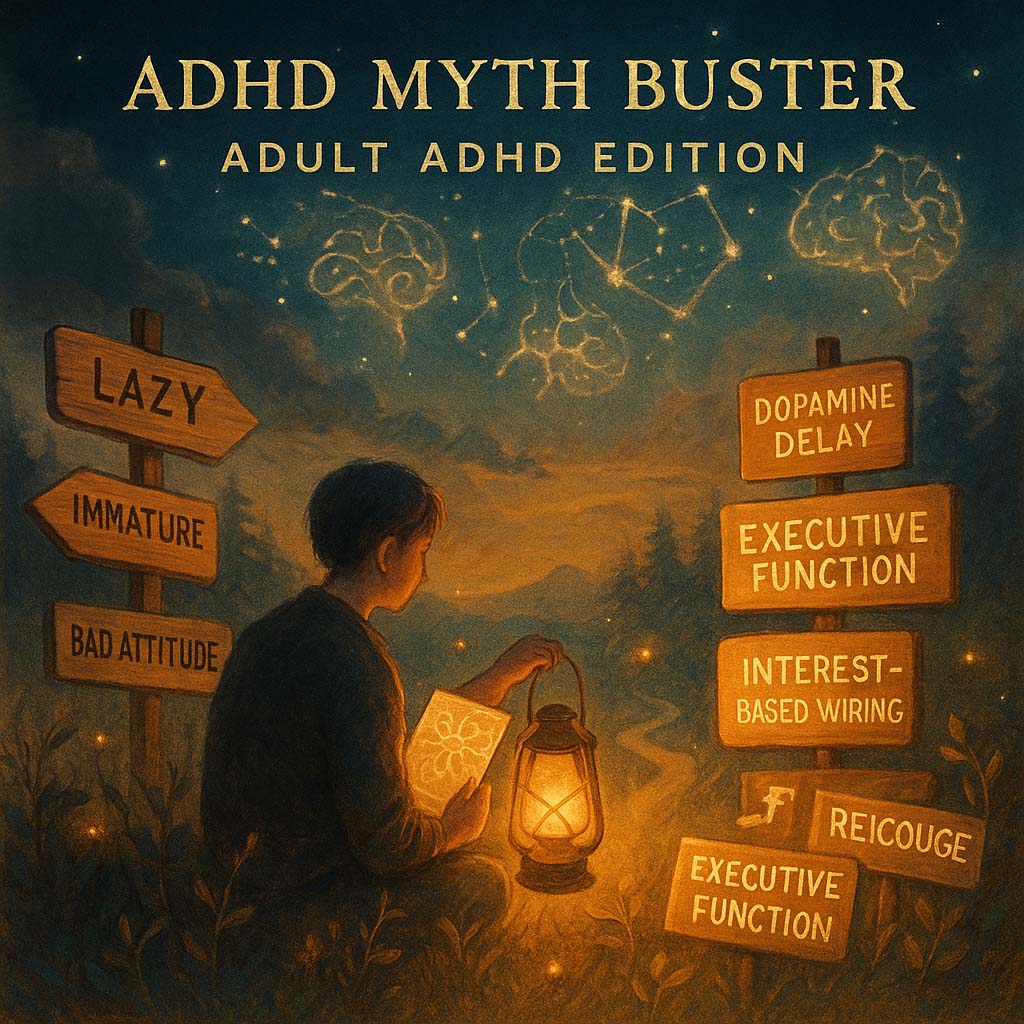
🌱 T – Thrive Together
“It’s not about trying harder. It’s about working differently.”
When a loved one is diagnosed with ADHD in adulthood, it can bring both relief and confusion. This Myth Buster is here to help families let go of outdated ideas and start building a foundation of understanding and support.
🚫 Myth #1: “ADHD is just a childhood issue. They should’ve outgrown it.”
✅ Truth: ADHD is a lifelong condition. While hyperactivity might ease with age, executive function challenges — like planning, focus, emotional regulation, and time management — often persist and even intensify under adult demands.
🚫 Myth #2: “They just need more discipline and motivation.”
✅ Truth: ADHD affects the brain’s self-regulation systems — especially in the prefrontal cortex. This means motivation isn’t always tied to importance or intention. Instead, people with ADHD may respond more to novelty, urgency, and emotional salience.
🚫 Myth #3: “If they can focus on things they like, it means they’re just being lazy.”
✅ Truth: This is called interest-based nervous system wiring. Adults with ADHD may enter hyperfocus when something is intrinsically engaging, yet still struggle to initiate or sustain effort on everyday, lower-stimulus tasks — even ones they care about.
🚫 Myth #4: “They’re just making excuses for poor behaviour.”
✅ Truth: ADHD is not an excuse — it’s an explanation. Recognising the root of the behaviour allows for more effective support, accountability strategies, and growth. Understanding reduces shame and increases capacity for change.
🚫 Myth #5: “They’re being disrespectful when they forget or interrupt.”
✅ Truth: Working memory, impulse control, and emotional filtering are all affected by ADHD. Interrupting or forgetting is often a symptom of neurological lag — not lack of love or care.
🌿 Family Insight: The shift from judgment to curiosity is where healing begins. Once you learn why your loved one’s brain behaves the way it does, you can build the kinds of supports that actually work — and strengthen your connection in the process.
❓Family FAQs
These questions cover the common concerns families have — from communication and boundaries to motivation and medication — helping you support your loved one with more clarity, compassion, and confidence.
Mon - Fri: 8AM - 6PM
Sat - Sun: Variable
Brisbane North Medical Specialists,
15 Dallas Parade, Keperra, QLD 4054
(07) 5221 3489
reception@bnms.com.au





